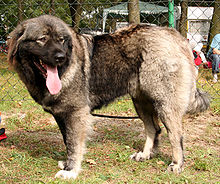Caucasian Shepherd Dog
| Caucasian Shepherd Dog | |||||||||||||||||||||||||
|---|---|---|---|---|---|---|---|---|---|---|---|---|---|---|---|---|---|---|---|---|---|---|---|---|---|
 | |||||||||||||||||||||||||
| Other names |
| ||||||||||||||||||||||||
| Origin | Caucasus | ||||||||||||||||||||||||
| |||||||||||||||||||||||||
| |||||||||||||||||||||||||
| Dog (domestic dog) | |||||||||||||||||||||||||

The Caucasian Shepherd Dog or Caucasian Ovcharka is a large livestock guardian dog native to the Caucasus region, notably Georgia, Armenia, Azerbaijan, and Dagestan.[1] It was bred in the Soviet Union from about 1920 from dogs of the Caucasus Mountains and the steppe regions of Southern Russia.[2] The Caucasus Mountains in Georgia has historically been the principal region of distribution of Caucasian Shepherd dogs, both in terms of numbers and the quality of the dogs present in the area.[1]
History
[edit]For centuries dogs similar to the Caucasian mountain dogs have served shepherds in the Caucasus Mountains as livestock guardian dogs,[3]: 269 defending sheep from predators, mainly wolves and human sheep-thieves.[4]: 399 These dogs are distributed over a wide area, and there are considerable regional variations: those in Azerbaijan are fairly tall and lightly built; those in Dagestan are smaller and roughly square in outline; those of the former Checheno-Ingush ASSR, now Ingushetia and Chechnya, are heavily built and very large.[5]: 58 It is widely accepted that those of Georgia are better and more uniform than those of other regions.[5]: 58
During the twentieth century Soviet breeders selected some of these varieties among Caucasian dogs and created the Caucasian Shepherd Dog breed. Caucasian shepherds were first scientifically described by the Russian cynologist Aleksandr Mazover,[1] noting that the center of distribution of the breed, both in terms of numbers and quality, were Georgia, Azerbaijan, Armenia and Dagestan.[1] While the dogs from different areas of the region shared the general features today present in Caucasian shepherds, Caucasian Shepherds from Georgia were considered to be the best examples of the breed due to their size, powerful musculoskeletal structure, and attractive long fur. For this reason, the Georgian SSR became the principal region for cultivating Caucasian Shepherd dogs in the Soviet Union.[1]
The breed was definitively accepted by the Fédération Cynologique Internationale in 1984, under the patronage of the Soviet Union.[6]
Characteristics
[edit]The Caucasian Ovcharka is a large dog, usually weighing 45–70 kg (99–154 lb).[7]: 71 The preferred height at the withers is in the range 67–70 cm (26–28 in) for bitches, and 72–75 cm (28–30 in) for dogs;[2] the minimum heights and weights for registration are 64 cm (25 in) and 40 kg (88 lb) for bitches, and 68 cm (27 in) and 50 kg (110 lb) for dogs.[2] Life expectancy was reported in 2020 at 10–11 years;[7]: 71 a study published in 2024 found the median lifespan to be 5.4 years, the lowest in all breeds studied.[8]
In appearance, it closely resembles the Kars dog.[9][10]
Use
[edit]Caucasian Shepherd Dogs used to serve as guard dogs and bear hunting dogs and today they work as prison guard dogs in Russia.[11]
Restrictions
[edit]The breed is banned in Denmark[12] and subject to restrictions in Russia.[13]
Health
[edit]A study in the UK found a life expectancy of 5.4 years for the breed which was the lowest of all 155 included breeds; however, the sample size was just 22 dogs.[8]
References
[edit]- ^ a b c d e Aleksandr, Mazover. Племенное дело в служебном собаководстве (Breeding of working dogs). pp. 2, 3. Retrieved 27 August 2020.
- ^ a b c FCI-Standard N° 328: Caucasian Shepherd Dog (Kavkazskaïa Ovtcharka). Fédération Cynologique Internationale. Accessed July 2020.
- ^ Bonnie Wilcox, Chris Walkowicz (1993). Atlas of Dog Breeds of the World, fourth edition. Neptune City, New Jersey: TFH Publications. ISBN 0866228551
- ^ Desmond Morris (2002). Dogs: A Dictionary of Dog Breeds. North Pomfret, Vermont: Trafalgar Square Publishing. ISBN 9781570762192.
- ^ a b David Hancock (2014). Dogs of the Shepherds: a Review of the Pastoral Breeds. Ramsbury, Marlborough, Wiltshire: The Crowood Press Ltd. ISBN 9781847978080.
- ^ FCI breeds nomenclature: Kavkazskaïa Ovtcharka (328). Fédération Cynologique Internationale. Accessed July 2020.
- ^ a b Kim Dennis-Bryan (2020 [2012])). The Complete Dog Breed Book, second edition. London: Dorling Kindersley. ISBN 9780241412732.
- ^ a b Kirsten M. McMillan, Jon Bielby, Carys L. Williams, Melissa M. Upjohn, Rachel A. Casey, Robert M. Christley (2024). Longevity of companion dog breeds: those at risk from early death. Scientific Reports. 14, article 531. doi:10.1038/s41598-023-50458-w.
- ^ Morris, Desmond (2001). Dogs: the ultimate dictionary of over 1,000 dog breeds. North Pomfret, VT: Trafalgar Square Publishing. p. 396. ISBN 1-57076-219-8.
- ^ Yilmaz, Orhan; Ertuğrul, Mehmet; Wilson, R Trevor (2012). "The domestic livestock resources of Turkey: breed descriptions and status of guard and hunting dogs". 63rd Annual Meeting of the EAAP. 63 (1). European Association of Animal Production: 69. Retrieved 30 October 2020.
- ^ "Caucasian shepherd dogs bred for hunting Russian bears go on sale in Northern Ireland for first time". Belfasttelegraph. Retrieved 1 January 2019.
- ^ "Danish Legislation on Dogs". Danish Ministry of Food, Agriculture and Fisheries. Archived from the original on 5 July 2013. Retrieved 29 December 2022.
- ^ "Russia's Interior Ministry compiles list of potentially dangerous dog breeds". TASS. Retrieved 29 December 2022.
